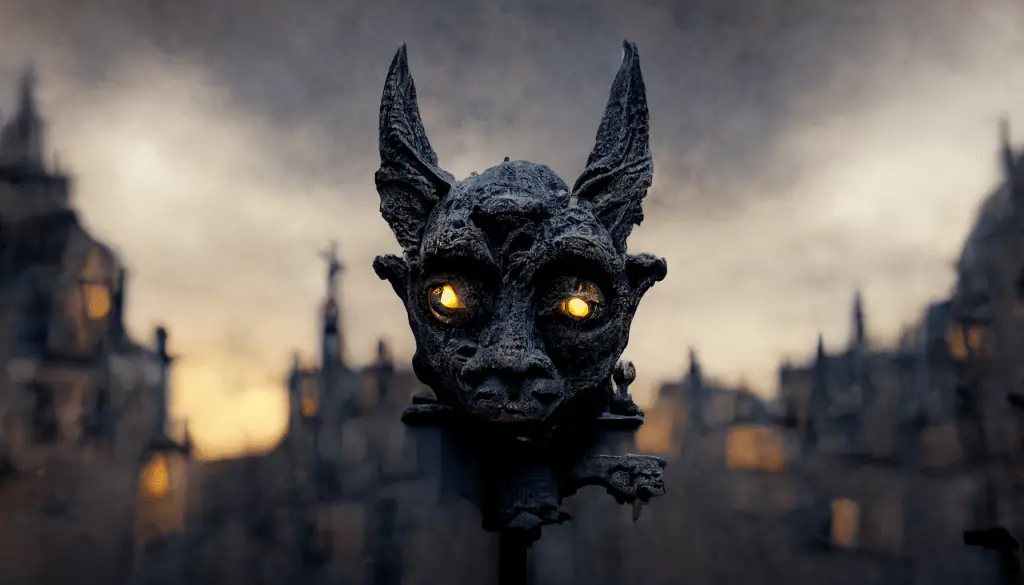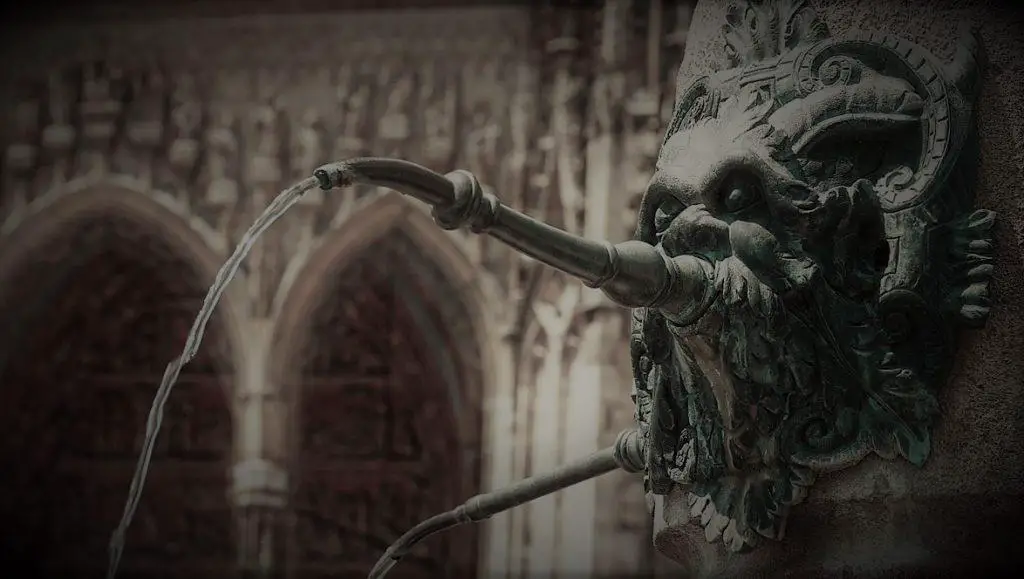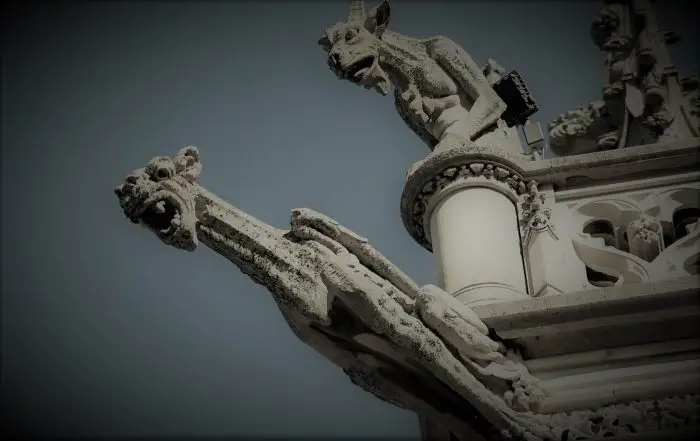Share the Lore!
By: Andrej Jovanovski
Stone Protectors or Creatures of Chaos
We’ve all seen or at least heard of a gargoyle, be it from cartoons and movies, shows, or video games, we’re all aware of what gargoyles look like.
Originating from Ancient Egypt, gargoyles are chimeras that used to resemble a lion, yet, once Gothic architecture took Europe by storm, they became stone-carved dragons with bat-like wings.
Practically, the purpose of a gargoyle was to protect from rainwater, preventing erosion to the walls of the holy places, while enhancing the aesthetics of the temples.
This is how the myth that gargoyles can communicate with humans when wind or rain passes through their mouths came to be.
Traditionally, gargoyles were considered to be protectors of Catholic cathedrals, warding off evil spirits and demons. Yet, in recent years gargoyles have been described as demon-like creatures made of stone, causing chaos wherever they appear.

From Protectors to Demons
During the renaissance an old French legend washed to the surface, saying that St. Romanus subdued a creature known as La Gargouile with a crucifix and hung its head on top of a cathedral in order to ward off other demons.
La Gargouile is described as a dragon with bat-like wings, which has been often considered to be the first gargoyle in Christian architecture.
With this legend spreading like wildfire and keeping its relevance up till the XX century, the idea of gargoyles being supernatural constructs brought to life by evil was introduced in the 1932 short pulp fiction story Maker of Gargoyles, where a medieval stonemason unconsciously infuses his hate into two gargoyles.
In the same year, the notion of gargoyles being demonic vessels was introduced in The Horn of Vapula, written by Lewis Spence.
Together with the fact that after the 18th-century gargoyles became much less common because of modern drainpipes, the birth of the idea of gargoyles as demons came to relevance, causing their origin as protectors to be forgotten, forever changing our perception of them.
Difference Between Gargoyles as Possessed Statues and Gargoyles as a Race
One thing that all gargoyles share in common is their ability to stay in one place appearing as statues, yet, what we often fail to realize is that there are two types of gargoyles, and no I’m not talking about good and bad ones.
When someone mentions gargoyles, the first thing that comes to our mind is a statue that had come to life, usually by being possessed by a demon, with the sole intention of causing harm to humanity, as depicted in the cult-classic movie Gargoyles.
The second gargoyles we should look at are creatures that are considered to be a completely different race, being sentient and alive.
They are often portrayed as bat-like creatures who have the ability to turn into stone, however, unlike the gargoyles that are possessed statues, they are neither good nor bad, attacking humans only when they feel threatened.
Gargoyles in Pop-Culture
Being chimerae that have existed for at least three millenniums, gargoyles have always been seen as fascinating creatures, even though our perception of them has drastically changed as stated before.
During Halloween it is not uncommon to see gargoyles decorating homes, being part of carnivals, and even having people dressed like them, portraying them as protectors by warding off evil spirits.
Another commonplace that we can find them during Halloween are haunted houses, where gargoyles play a more sinister role, being depicted as demonically possessed statues.
Gargoyles have been a huge inspiration to the entertainment industry, often appearing in film and television, in comics by being the inspiration for two fictional characters in the Marvel universe that share the name Gargoyle, and appearing in almost every fantasy-based game.
Unlike the previously mentioned movie Gargoyles, the TV show Gargoyles shows these creatures as night-time protectors of modern-day New York City.
Another portrayal of friendly gargoyles can be found in The Hunchback of Notre Dame as Hugo, Victor and Laverne embody Quasimodo’s subconsciousness.
In The Witcher 3, we can find gargoyles who guard mage’s laboratories. They are stone statues that were brought to life by magic.
In the Warcraft franchise, gargoyles are a unique race of voracious flying creatures that were brought to Lordaeron from Northrend in order to wreak havoc.
In League of Legends, Galio, the Colossus is a gigantic gargoyle that was created to protect Demacia and served as its symbol.
In the fantasy role-playing game Dungeons & Dragons, the gargoyles were one of the first monsters introduced where they were described as reptilian beasts, with a chaotic nature.
With this, we can see that even in popular culture the portrayal of gargoyles as protectors or machines of chaos is a topic that’s still being discussed.
Is There Room for Fear?
Now that all of this has been said we are left with one question.
Do gargoyles really exist?
The truth is, yes, they do exist! However, they are nothing more than just a grotesque part of the architecture that has helped churches and temples deal with rainwater.

However, it’s really hard to disprove that gargoyles aren’t protecting the places from which they rest. Although being created by humans, the power bestowed into them to ward off evil spirits and demons comes from their nature, scary looks, and the sounds they produce thanks to the wind.
Yet to say that the possibility of gargoyles can’t be possessed is nonexistent and something we can’t do with great certainty.
FAQs
What are gargoyles made of?
Most gargoyles are made of stone. Although, there are gargoyles that have flesh, such as the ones from Warcraft, and gargoyles made of wood as seen in Wizard of Oz.
What are the most famous gargoyles?
There is no single gargoyle that is most famous, however, the gargoyles of Notre Dame have been considered as the most well-known ones.
Where do gargoyles originate from?
The first recognized gargoyles come from ancient Egypt where they were shown to have a lion’s head.
Do all gargoyles have bodies?
No, there are known gargoyles that only show the neck and the head of the animal. A good example of this is the Chinese Chiwen, a dragon that has been made into countless gargoyles all around China.
References:
What Is a Gargoyle? https://wonderopolis.org/wonder/what-is-a-gargoyle , Accessed 8 August 2021 Gargoyle, Merriam-Webster, 2015. https://www.merriam-webster.com/word-of-the-day/gargoyle-2015-09-05, Accessed 8 August 2021 J.B. Tschen-Emmons, Artifacts from Medieval Europe, ABC-CLIO, pp. 72-73

